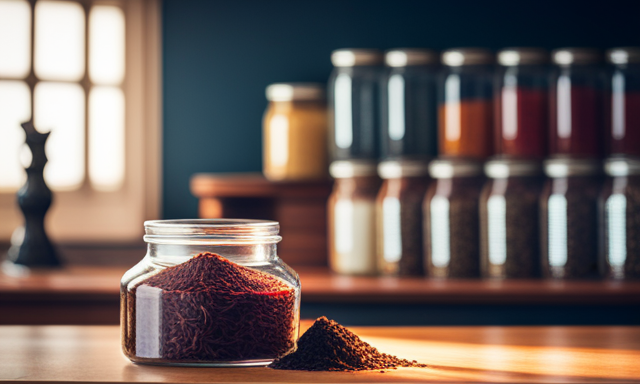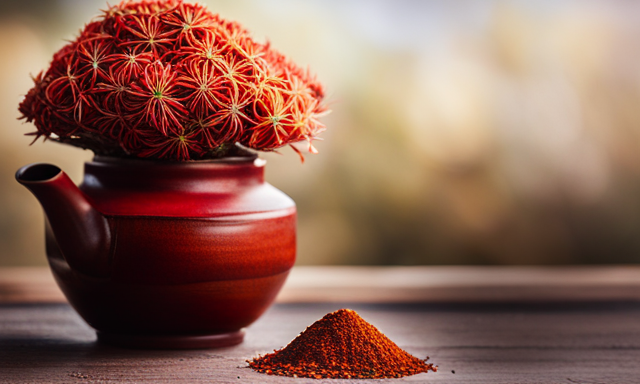Are you a fan of rooibos tea but find it a bit too bitter for your taste? Well, you’re in luck because I have the perfect solution for you – how to sweeten your rooibos tea to perfection!
In this article, I will share with you some tried and tested methods to enhance the natural flavor of rooibos tea and make it delightfully sweet. From experimenting with different sweeteners to adding fruits, herbs, and spices, I will guide you through the process step by step.
I’ll also give you tips on steeping the tea longer for a sweeter brew and blending it with other sweet teas or infusions for an extra burst of flavor. And of course, I’ll suggest some delectable accompaniments to serve with your sweetened rooibos tea.
So, get ready to elevate your tea-drinking experience and share the joy of a perfectly sweetened cup of rooibos tea with others. Let’s get started!
Key Takeaways
- Blending rooibos tea with other sweet teas or infusions creates a more complex flavor profile and allows you to enjoy the health benefits of different teas in one cup.
- Adding honey or cinnamon to rooibos tea brings out its natural sweetness.
- Pair rooibos tea with sweet treats like pastries, cookies, chocolate-covered strawberries, or spiced honey to enhance the flavor of both.
- Gather loved ones and sip on sweetened rooibos tea together to create cherished memories.
Understand the Natural Flavor of Rooibos Tea
You’ll love the unique natural flavor of rooibos tea! It’s a delicious herbal beverage that offers a wide range of taste profiles.
When brewed properly, rooibos tea has a rich and earthy flavor with undertones of sweetness. However, many people don’t realize that there are also different flavor profiles to discover. By experimenting with brewing times and temperatures, you can uncover hidden sweetness or even hints of nuttiness or floral notes. The key is to find the perfect balance that suits your taste preferences.
In the next section, I’ll show you how to experiment with different sweeteners to enhance the natural flavors of rooibos tea.
Let’s dive in!
Experiment with Different Sweeteners
Explore various options to enhance the flavor of your delicious red herbal infusion by experimenting with different sweeteners. Sweetening your rooibos tea can add a touch of indulgence and balance out any bitterness. When it comes to sweeteners, there are many choices to consider. One popular option is honey, which not only adds sweetness but also imparts its own unique flavor profile. You can try different types of honey, such as clover, wildflower, or manuka, to find your preferred taste. Another option is to experiment with different types of sugar, like brown sugar, raw sugar, or even coconut sugar. Each sweetener will bring its own distinct flavor and sweetness level to your tea. Don’t be afraid to get creative and find the perfect sweetener that suits your palate. In the next section, we’ll explore how to enhance the flavor with fruits and herbs, taking your rooibos tea to the next level.
Enhance the Flavor with Fruits and Herbs
When it comes to enhancing the flavor of rooibos tea, there are several options to consider. One option is to infuse the tea with citrus fruits, such as lemon or orange, for a tangy twist that adds a refreshing kick to your cup.
Another option is to add a hint of mint or lavender, which can provide a cool and refreshing flavor that pairs well with the earthiness of rooibos tea.
Lastly, you can explore the sweetness of berries or peach slices, which can add a natural sweetness and fruity flavor to your tea.
So, whether you prefer a tangy twist, a refreshing kick, or a fruity sweetness, there are plenty of options to experiment with when it comes to enhancing the flavor of your rooibos tea.
Infuse Your Tea with Citrus Fruits for a Tangy Twist
Add a burst of refreshing citrus flavor to your rooibos tea by infusing it with tangy fruits like lemons or oranges. Citrus fruits not only enhance the taste of your tea, but they also provide numerous health benefits. When combined with rooibos tea, citrus fruits create a delightful and invigorating blend that’s perfect for any time of the day.
The zesty and tangy notes of citrus complement the natural sweetness of rooibos, resulting in a truly delightful experience for your taste buds. Citrus fruits are rich in vitamin C, which boosts your immune system and promotes overall well-being. So, why not take your rooibos tea to the next level by infusing it with the vibrant flavors of citrus fruits?
As we move into the next section, let’s explore how you can add a hint of mint or lavender for a refreshing flavor.
Add a Hint of Mint or Lavender for a Refreshing Flavor
Enhance your tea experience with the invigorating flavors of mint or lavender, creating a refreshing twist that’ll leave your taste buds tingling with delight.
Mint and lavender make a perfect pairing for rooibos tea, offering a burst of freshness and a soothing aroma. To infuse your tea with these refreshing flavors, simply add a few sprigs of fresh mint leaves or a teaspoon of dried lavender to your steeping cup. Allow the tea to brew for a few minutes, allowing the flavors to meld together.
The result is a delightful and aromatic beverage that complements the earthy sweetness of rooibos tea perfectly. Soothing and invigorating, mint and lavender take your rooibos tea to new heights of flavor.
Now, let’s explore the sweetness of berries or peach slices for an added burst of fruity goodness.
Explore the Sweetness of Berries or Peach Slices
Indulge in the lusciousness of fresh berries or juicy peach slices to elevate your tea experience to new levels of fruity delight. These natural additions bring a burst of sweetness and a hint of tanginess that perfectly complements the earthy flavor of rooibos tea. Whether you prefer the classic combination of berries and cream or the comforting taste of peach cobbler, adding these fruits to your tea will create a delightful treat for your taste buds. To make it easier for you to decide which fruit to choose, here is a handy table comparing the flavors and characteristics of berries and peaches:
| Berries | Peaches |
|---|---|
| Sweet | Juicy |
| Tart | Fragrant |
| Vibrant | Smooth |
| Versatile | Succulent |
| Nutrient-rich | Aromatic |
By incorporating these juicy fruits into your rooibos tea, you can create a delicious and refreshing beverage that is reminiscent of a summer dessert. Now, let’s explore how to use spices to add depth and sweetness to your tea.
Use Spices to Add Depth and Sweetness
Spice up your sweet rooibos tea with a dash of cinnamon and a pinch of cloves for a delectable depth of flavor. Adding spices to your tea not only enhances its taste but also offers a range of health benefits.
Cinnamon, with its warm and sweet notes, complements the natural sweetness of rooibos tea. It adds a comforting aroma and can help regulate blood sugar levels.
Cloves, on the other hand, provide a hint of spiciness and a touch of sweetness. They are known for their antioxidant properties and can aid digestion.
To create this spiced infusion, simply add a small piece of cinnamon stick and a couple of cloves to your tea while it steeps. Let the flavors meld together for a few minutes before enjoying a cup of this delightful and naturally sweetened brew.
By using spices, you can take your sweet rooibos tea to the next level and create a truly indulgent experience.
To continue enhancing the sweetness of your brew, let’s explore how steeping the tea longer can result in a sweeter cup.
Steep the Tea Longer for a Sweeter Brew
To achieve a sweeter cup of tea, try steeping it for a longer duration, allowing the flavors to fully develop and intensify. Steeping rooibos tea for an extended period of time can enhance its natural sweetness and create a more indulgent brew. Here are three key points to consider when experimenting with different steeping times:
-
Longer Steeping Time: Increase the steeping time gradually, starting with an extra minute or two. This will allow the tea leaves to release more flavor and sweetness into the brew.
-
Temperature Control: Maintain the water temperature at around 200°F (93°C) during the extended steeping process. This ensures that the tea extracts the best flavors without becoming bitter.
-
Health Benefits: Rooibos tea is known for its numerous health benefits, including its high antioxidant content and potential to support heart health. By steeping it longer, you can maximize these benefits and enjoy a sweeter cup of tea.
To further enhance the sweetness, consider blending rooibos tea with other naturally sweet teas or infusions. This combination can create a delightful and unique flavor profile.
Consider Blending Rooibos Tea with Other Sweet Teas or Infusions
After steeping the rooibos tea longer, another way to achieve a sweeter brew is by considering blending it with other sweet teas or infusions. This opens up a whole world of possibilities to enhance the flavor profile of your rooibos tea.
Blending options are endless, from adding a touch of honeybush tea for a naturally sweet taste to infusing it with fruity teas like peach or strawberry. Not only does blending rooibos tea with other teas create a more complex and enjoyable flavor, but it also allows you to reap the health benefits of different teas in one cup.
For example, adding green tea can introduce antioxidants, while chamomile tea can promote relaxation. Experiment with different combinations to find your perfect blend.
Now, let’s move on to the next section where we’ll explore how to serve your rooibos tea with sweet accompaniments.
Serve Your Rooibos Tea with Sweet Accompaniments
One delicious way to enjoy your cup of rooibos tea is by pairing it with a variety of delectable treats such as pastries or cookies, which can enhance the overall experience. Did you know that studies have shown that consuming tea with sweets can actually enhance the flavor of both?
Here are some sweet accompaniments for rooibos tea that you can try:
-
Freshly baked scones with clotted cream and jam
-
Chocolate-covered strawberries for a decadent twist
-
Spiced honey drizzled over your tea for a unique flavor
These sweet treats complement the natural sweetness of rooibos tea, creating a delightful balance of flavors. By experimenting with different combinations, you can find the perfect accompaniment to enhance your tea-drinking experience.
Now that you know how to sweeten your rooibos tea, it’s time to enjoy your sweetened rooibos tea and share the joy with others.
Enjoy Your Sweetened Rooibos Tea and Share the Joy with Others
Indulge in the delightful experience of enjoying your sweetened rooibos tea with loved ones, sharing the joy and creating lasting memories. There are various sweetened rooibos tea recipes that can enhance your tea-drinking experience. Adding a touch of honey or a sprinkle of cinnamon can bring out the natural sweetness of rooibos tea. Not only does it taste great, but rooibos tea also offers numerous health benefits. It is packed with antioxidants that can help boost your immune system and promote overall well-being. Rooibos tea is also caffeine-free, making it a perfect choice for those looking for a soothing and relaxing drink. So, gather your loved ones, sit around a table, and sip on your sweetened rooibos tea while creating cherished memories together.
| Sweetened Rooibos Tea Recipes | Benefits of Drinking Rooibos Tea | Share the Joy |
|---|---|---|
| Honey and Rooibos | Boosts Immune System | Create Memories |
| Cinnamon and Rooibos | Promotes Well-Being | Enjoy Together |
| Caffeine-Free | ||
| Soothing and Relaxing |
Frequently Asked Questions
Can I use artificial sweeteners instead of natural sweeteners in rooibos tea?
Using artificial sweeteners in rooibos tea is possible, but it has its pros and cons. While it can provide a sugar-free option, some artificial sweeteners may have a distinct aftertaste. It’s best to experiment and find one that suits your taste preferences.
How long should I steep rooibos tea to achieve the perfect sweetness?
To achieve the perfect sweetness in rooibos tea, steep it for 5-7 minutes. This allows the natural flavors to develop fully. For added sweetness, you can also try adding honey or a natural sweetener of your choice.
Are there any specific fruits or herbs that pair well with rooibos tea?
Fruits like orange, peach, and strawberry pair well with rooibos tea, adding a natural sweetness and enhancing its flavor. Additionally, herbs like mint and lavender can provide a refreshing and aromatic twist to your cup of rooibos tea.
Can I add milk or cream to my sweetened rooibos tea?
Absolutely! Adding milk or cream to sweetened rooibos tea is like pouring a velvety cloud into your cup. The pros include a creamy texture and a smoother, milder taste. However, be cautious as dairy can overpower the delicate flavors of rooibos.
Is it possible to make a cold or iced version of sweetened rooibos tea?
Yes, it is possible to make a cold version of sweetened rooibos tea. It’s a refreshing alternative that retains the health benefits of rooibos, such as its high antioxidant content and potential to support heart health.
Conclusion
In conclusion, sweetening rooibos tea is a delightful way to enhance its natural flavor and create a truly enjoyable beverage. By experimenting with different sweeteners, fruits, herbs, and spices, you can add depth and sweetness to your brew.
While some may argue that adding sweeteners takes away from the tea’s purity, it’s important to note that personal preferences vary and there’s no right or wrong way to enjoy rooibos tea.
So go ahead, indulge in a cup of sweetened rooibos tea and share the joy with others.










